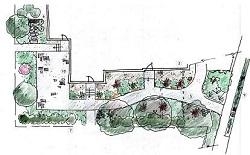By Denise Seghesio Levine, UC Master Gardener of Napa County
First, a disclaimer. While there are many wonderful landscape and garden designers who are Master Gardeners, I am not one of them. Garden design is still pretty experimental for me even after all these years.
After taking seminars and classes and reading books and articles on designing a garden, it seems to all come down to questions. Where are you? How much space do you have? How much time do you have? How much water do you have and where does the sun shine? Are you in town or does your garden blend into the surrounding landscape? Do you need fences and do you have deer?
Are you craving a colorful, disheveled explosion of flowers and a whimsical cottage-chic retreat, or the stark repetition of agave plants and background of gravel for a calming, low-maintenance, meditative space? Do you have a blank canvas of a subdivision plot around a new house, a corner yet undone in an otherwise well-established garden, or even just a deck, patio or balcony to bring the outdoors in? A well-designed garden can be a haven, create an attractive frame and curb appeal for your home and provide privacy so it is worth taking the time to think about it.
I have a longtime friend, a botanist and herbal gardener, whose familial roots trace back to an old Scottish castle. Several years ago, he was honored to be tasked with restoring and recreating the historic gardens that used to surround the family castle. The gardens had been abandoned decades, if not centuries, ago.
His garden restoration design was guided by necessary historical references. The boundaries were set, the plant lists were recorded, the scale was predetermined by the magnitude of the stark, angular castle and the steep terrain that sloped up to it.
We usually do not have such dramatic limitations and can branch out into our garden wish list with more abandon. Yet, if you have a new garden space to create or a tired spot to enliven or recreate, many of the same principles apply.
Garden designers consider contrast, proportion, balance, repetition and rhythm. Colors, enclosures, structures, shapes and textures are fun and necessary considerations as we imagine garden spaces. And depending on personal preferences, other criteria may be included.
I recently read an article about the original garden design at Disney's Epcot Center in Florida. Given that Epcot Center is built upon acres of swamp, Disney's main concern was mosquito control. To that end, none of the plants used has leaves that collect water. Mosquitos breed in standing water and not even leaf puddles are allowed in Disneyland. All the plants have waxy, sloping leaves and shed water into the mulch below.
But back to Napa. How can you pull your different garden spaces together so, at the end of your design journey, there is a feeling of cohesiveness and harmony?
Often this is where path and hardscape choices come in. Paths and outside living areas can be purely utilitarian or add to the whimsy or mood of your garden. Certainly, a straight concrete or aggregate patio or path lined with stark agaves has a different feel than redwood rounds or soft wood chips with nodding ferns and forget-me-nots softening the edges.
Look at your garden from all vantage points. Will the area be a private space enclosed with plants or open to a larger landscape? Perhaps the space you are designing is your view from a kitchen, living room or bedroom window. Drag a chair out, grab a cup of coffee or an evening beverage, and spend some time imagining. This is the part I am good at.
One mistake many new gardeners make when trying to achieve a colorful, diverse garden is to plant just one of each. Nature rarely does that. Planting in groups of three, five or seven is a basic, although flexible, rule for a natural look.
Stroll through your favorite nursery for plant ideas and advice. On hikes, note what grows together in nature. As you walk around your neighborhood, note which garden styles and plants you like. When considering a plant, learn its preferred sun exposure, soil requirements, watering needs and rate of growth. So many questions.
In our new Napa County reality, it is also a good idea to incorporate FireWise design principles. No shrubs or trees close to your foundation. Keep landscape trees limbed up. Avoid planting pampas grasses, resinous shrubs or other highly flammable plantings. Look online and at the University of California Cooperative Extension office for a list of FireWise plants. There are abundant magazines, books and online sources for diving into garden design on your own.
Workshop: “Sustainable Vegetable Growing” (Four-Part Series) on Sundays February 23, March 1, March 8 and March 15, from 2 p.m. to 4 p.m., at the University of California Cooperative Extension, 1710 Soscol Avenue, Napa. For more details & online registration go to Online registration (credit card only) or call 707-253-4221.
Workshop: “Step-by-Step Garden Design” on Saturday, February 29, from 9:30 a.m. to 11:30 a.m., at the University of California Cooperative Extension, 1710 Soscol Avenue, Napa. For more details & online registration go to On-line registration (credit card only) or
Mail-in/Walk-in registration (cash or check only) or call 707-253-4221.
The UC Master Gardeners of Napa County are volunteers who provide UC research-based information on home gardening and answer your questions. To find out more about upcoming programs or to ask a garden question, visit the Master Gardener website (http://napamg.ucanr.edu) or call (707) 253-4221 between 9 a.m. and noon on Mondays, Wednesdays or Fridays.
Attached Images:
